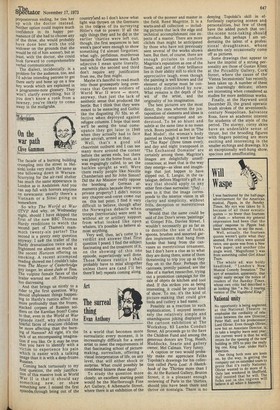rrelevn
On the war path
give Gammon
The facade of a burning building crumpling into the street in Helsinki looks very much the same as one billowing down in Warsaw. Scurrying for the air-raid shelter has much the same appearance in London as in Andalsnes. And you can sup full with horrors anytime on newscasts: usually there's a Vietnam or a Sinai going on somewhere.
So why The World at War (ITV)? And why, on, Wednesday night, should I have skipped the first of the new BBC Thomas Hardy renditions to watch the second part of Thames's mammoth twenty-six parter? The second is a pretty easy question anyway: I sad' the trailer of the Hardy dramatisation twice and it frightened me almost as much as the recent Horizon offering on smoking. A recent attempted reading showed me I couldn't take even The Mayor of Casterbridge any longer, let alone Jude or Tess. The vulpine female faces of the trailer warned me off. Potentially too distressing. And that brings us nicely to a rider to the first question. Why Should unpleasant things happening to Hardy's rustics affect me More profoundly than the frozen, stacked corpses of Russian soldiers on the Karelian front? Come to that, even in the World at War episode itself, why should the tearful faces of evacuee children be more affecting than the burning of Namsos? All right, it's the lack of an encompassing ithagination if you like. Or it may be true that you have to identify with a victim to experience his pain Which is easier with a talking image than it is with a deep-frozen Russian..
Coming back tortuously to my first question, the only justification of this massive look at World , War 11 is that it should say something new, or show something new. I missed the first spisodekthrough being out of the
countrylarld so I don't know what light was thrown on the Germans in the colirse of its surveying Hitler's rise to power. If all the ugly things they and he did in the earlier 'thirties were left out, though, the first sequences in last week's piece -were enough to show something I'd almost forgotten: what ugly, perfidious, murderous bastards the Germans were. Each adjective I mean quite literally, and while the second and third don't require any justification from me,. the first might.
Maybe it's fanciful to read much into those grotesquely long overcoats that German soldiers of World War 11 wore — more, anyway, than just the lack of aesthetic sense that produced the beetle. But I think that they were meant to be menacing and Gothic like the disgusting JU 52s, so effective when deployed against refugee columns. I hope that soon , we'll be seeing the total comeupance they got later in 1940 when they actually had to face other aircraft, armed at that.
Well, that's a good old chauvinist outburst and I can see
many more around the corner before the series ends, but there was plenty on the home front, as it was engagingly called, to set the hackles upright as well. Were there really people like Neville Chamberlain and Sir John Simon? Did the Air Minister really oppose the bombing of German armaments plants becauSe they were private property? I didn't notice any chapter-and-verse come out on this last point. I find it very difficult to believe, though after the Norwegian debacle when troops (territorials) were sent in without air or artillery support from what looked like open whalers, it's possible to believe almost anything.
Very well, then, let's come to a verdict and answer that first question I posed. I find the subject fascinating and the treatment of it, on the showing of this one
episode, superlatively well done. Those Wessex ruStics I shall probably have to missaltogether unless there are (and I'll bet there'll be!) repeats coming along.


































 Previous page
Previous page